CALGARY, AB / ACCESS Newswire / November 12, 2025 / Primary Hydrogen Corp. (TSXV:HDRO)(FRA:83W0)(OTCQB:HNATF) ("Primary" or the "Company") is pleased to report results from its recently completed Phase 2 field program at the Hopkins and Blakelock projects in Northern Ontario. The multi-phase exploration program, which covered 9,127 hectares and concluded in September 2025, identified multiple zones of anomalous hydrogen concentrations coincident with key geological features.
Key Highlights
Hopkins Project: Identified significant hydrogen anomaly peaking at 245 ppm H₂ with concentric distribution pattern near Clay-Howels Alkali Complex contact
Blakelock Project: Delineated 800-metre corridor of elevated H₂ values (averaging 52 ppm, peak 77 ppm) along north-south trending Matachewan mafic dyke
Technical Collaboration: Program conducted in partnership with Institut National de la Recherche Scientifique (INRS) to advance hydrogen sampling methodologies
Follow-up Planned: Results warrant expanded exploration to confirm readings and extend anomalous zones
"The Phase 2 exploration program at Hopkins and Blakelock has successfully identified multiple hydrogen anomalies that correspond with favorable geological features," stated Peter Lauder, P.Geo., Vice President of Exploration for Primary Hydrogen. "The spatial coherence of these anomalies, particularly their association with forest circles, fault structures, and mafic dykes, provides encouragement for continued investigation of these target areas."
Hopkins Project Results
Geological Setting
The Hopkins property is situated within the Kapuskasing Structural Zone of the Superior Province. The local geology comprises Precambrian metasedimentary paragneiss and migmatites, muscovite-bearing granitic rocks, and alkalic intrusives. Target features include northeast-trending faults, the Clay-Howels Alkali Complex formation, and multiple forest rings-circular vegetation anomalies that may indicate subsurface hydrogen seepage.
Hydrogen Soil Gas Analysis
The northeastern section of the property, positioned along the contact with the Clay-Howels Alkali Complex, was the focus of detailed soil gas sampling. Thirteen measurement stations were established across identified features, with hydrogen concentrations measured in situ at depths of 50-80 cm using Dräger XM-8000 and ATO Gas Dog H₂ portable detectors.
Results identified a spatially coherent circular anomaly characterized by:
Central peak concentration of 245 ppm H₂
Intermediate halo of 100-110 ppm H₂
Gradual tapering to background levels (<20 ppm H₂)
Secondary elevated value (~100 ppm H₂) extending southeast
Figure 1: Hopkins Project Overview
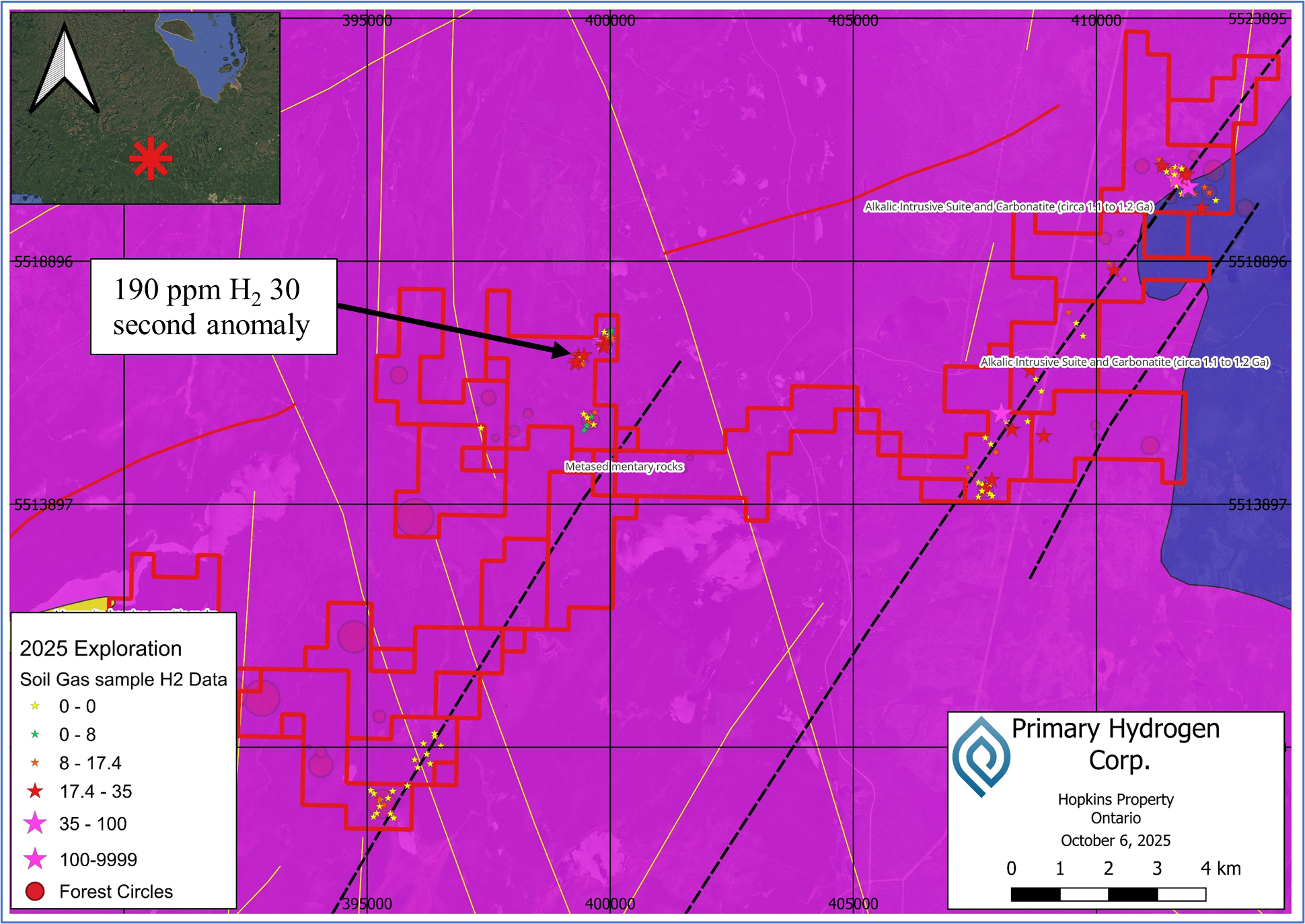
The concentric distribution pattern suggests a localized hydrogen leakage center, potentially indicating subsurface hydrogen accumulation or active generation.
Ambient Air Anomaly
During traverse between stations H062 and H056, field instruments detected a transient ambient air anomaly reaching 190 ppm H₂ over a 30-second interval. This unexpected reading, not associated with any sampling location, warrants further investigation.
Figure 2: Hopkins North Results
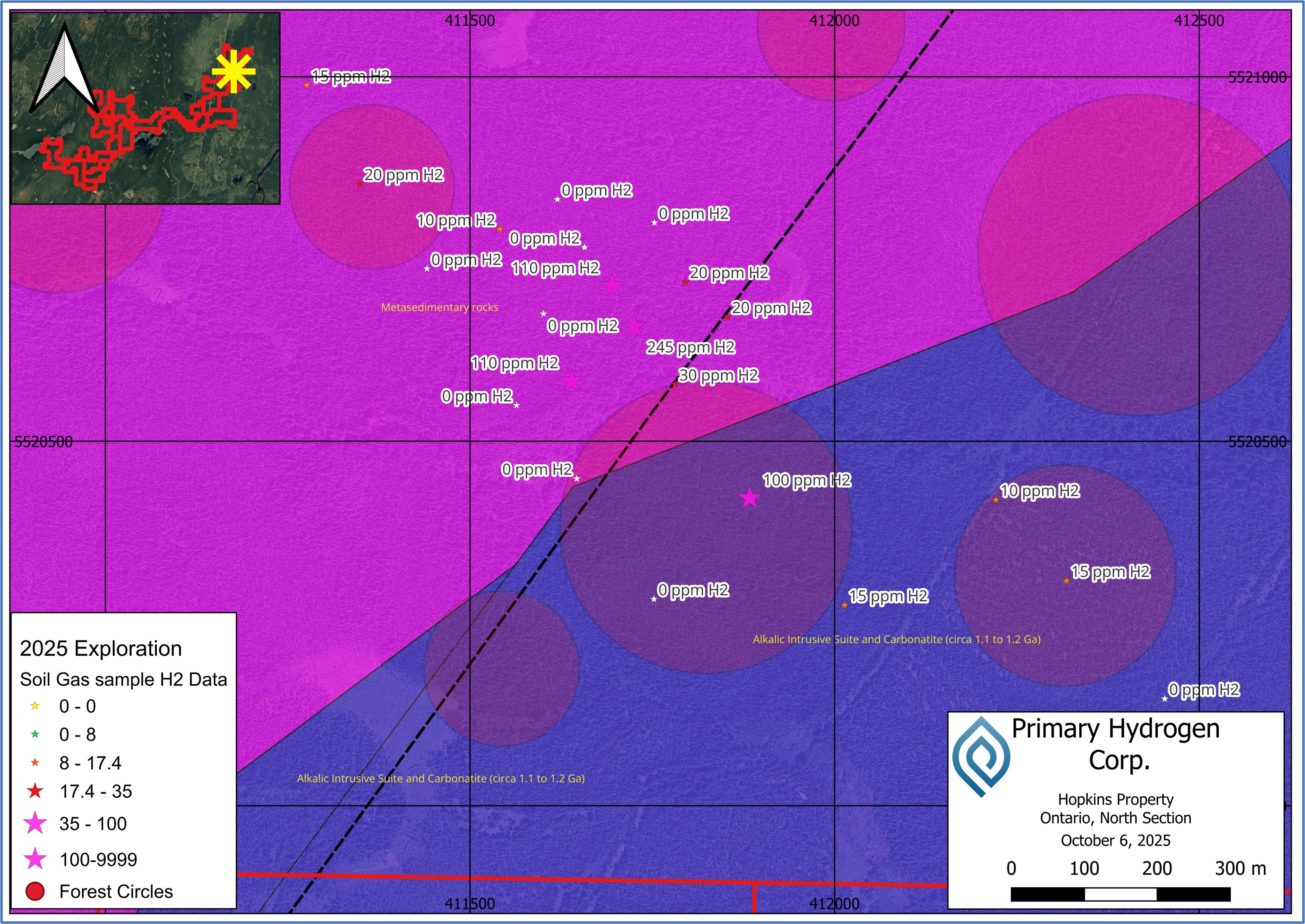
Blakelock Project Results
Geological Setting
The Blakelock claims are underlain by mafic to intermediate metavolcanic with intercalations of iron-rich sedimentary rocks intruded by mafic dykes, with the Norembega Iron Formation in proximity. The property is transected by multiple fault and fracture systems that may facilitate hydrogen migration. The combination of iron-rich lithologies and structural permeability creates favorable conditions for hydrogen generation and accumulation.
Hydrogen Soil Gas Analysis
Sampling focused on the southwestern sector where forest rings are concentrated. Results delineated a north-south trending corridor of elevated hydrogen values extending approximately 800 metres, spatially coincident with a Matachewan mafic dyke.
Key findings include:
Central corridor averaging 52 ppm H₂
Peak value of 77 ppm H₂
Spatial correlation with mapped mafic dyke
Potential indication of dyke-controlled hydrogen migration pathway
Figure 3: Blakelock Results
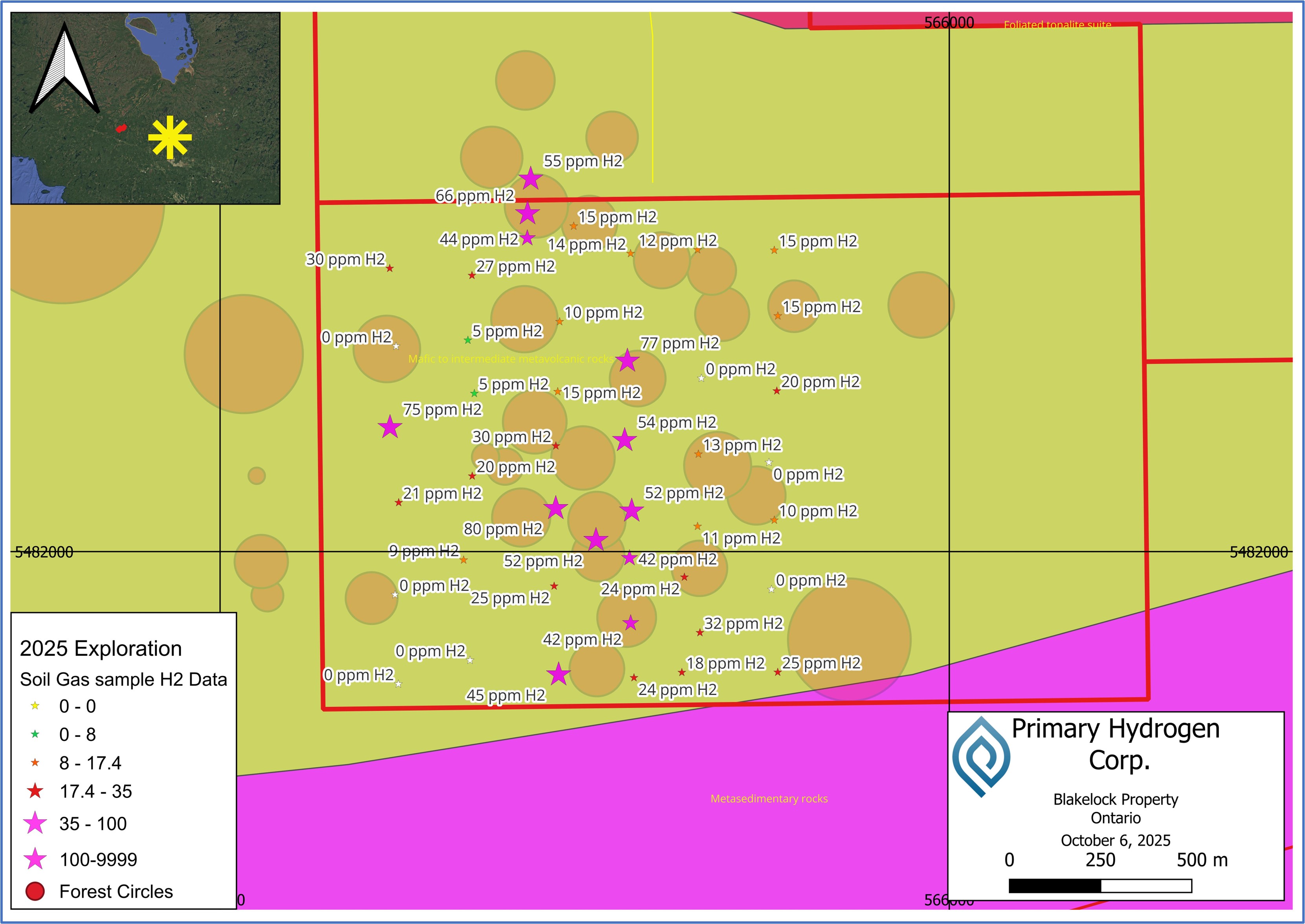
REE Soil Sampling
A complementary soil sampling program targeting rare earth elements (REE) was conducted across both properties. Seventy samples were collected from the humus horizon (20-50 cm depth) due to the absence of B-horizon development in the glacial terrain. Samples were analyzed at ALS Laboratory (Sudbury) using the ME-MS61r method.
Initial results indicate no anomalous REE concentrations above background levels. Six additional samples from the Hopkins carbonatite contact zone remain pending analysis.
Methodology and Quality Assurance
The exploration program employed an integrated approach combining:
Portable gas detection equipment (Dräger XM-8000, ATO Gas Dog H₂)
Conventional soil sampling and geological mapping
Laboratory-verified procedures developed with INRS to minimize artificially generated hydrogen
Real-time field measurements with systematic quality control protocols
All technical activities were conducted under the supervision of Peter Lauder, P.Geo., the Company's Qualified Person as defined under National Instrument 43-101.
Figure 4: Hopkins Ce ppm in Soils
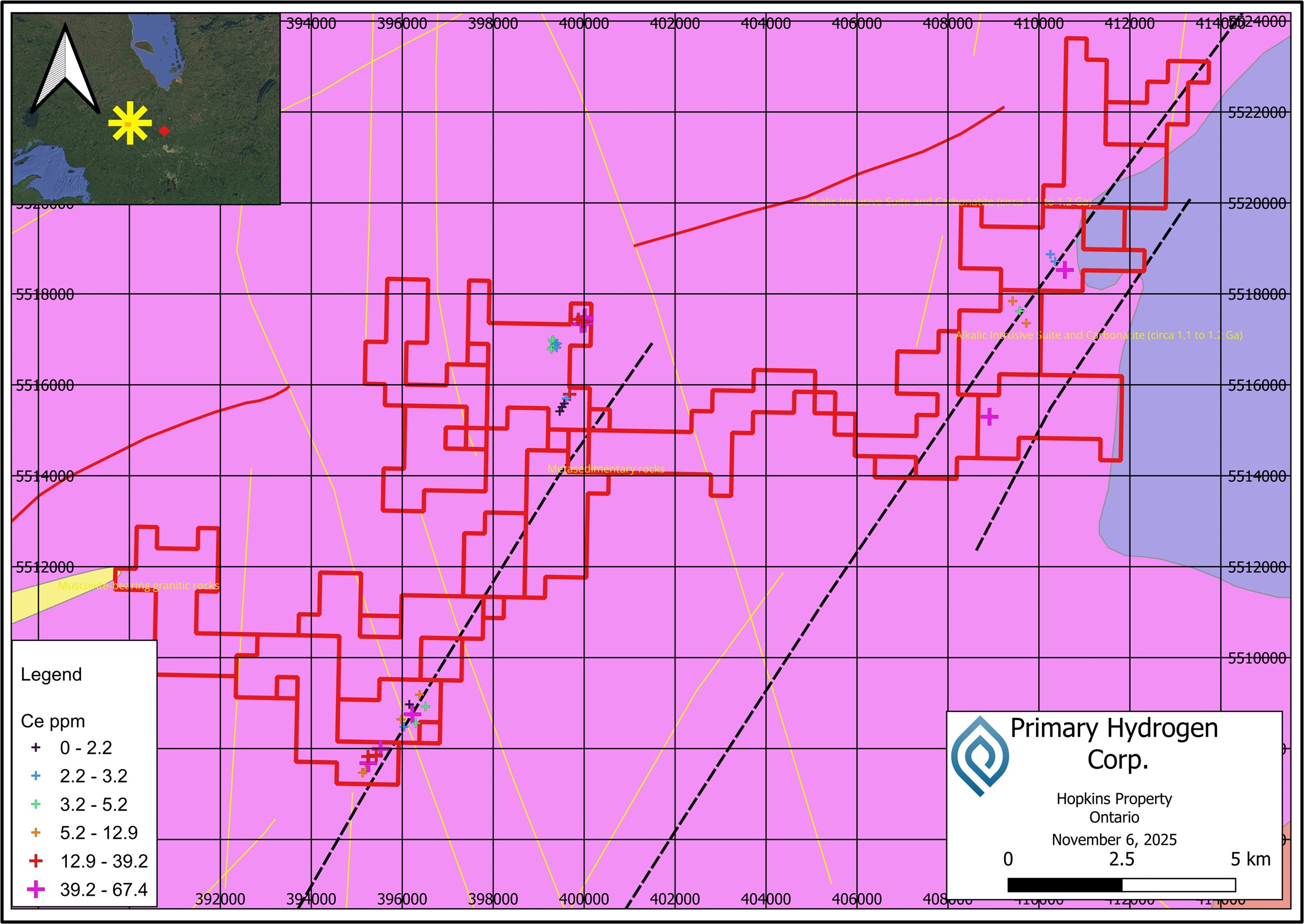
Figure 5: Blakelock Ce ppm in Soils
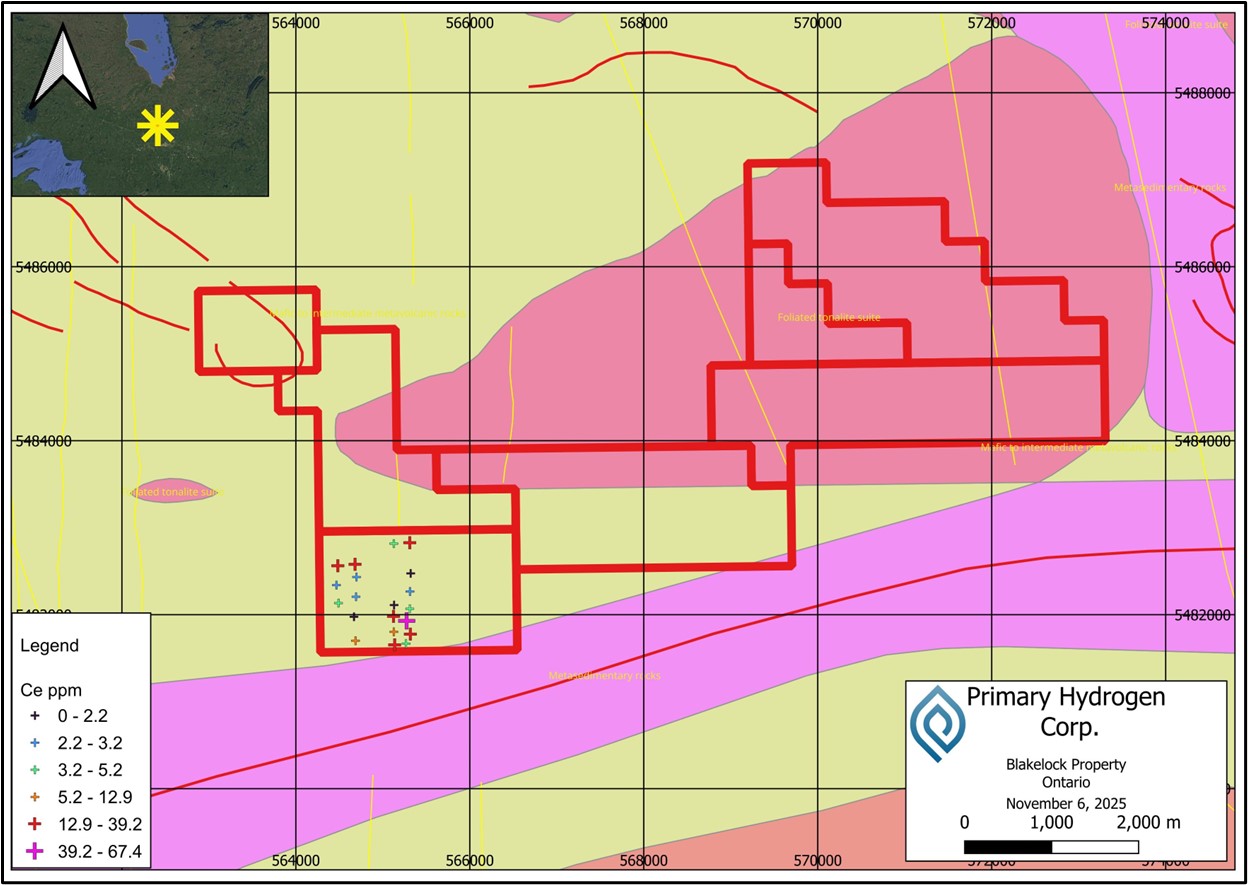
Next Steps
Based on the encouraging results from Phase 2, Primary Hydrogen plans to:
Conduct follow-up surveys to confirm anomalous readings
Expand sampling grids to delineate the full extent of hydrogen anomalies
Complete analysis of pending soil samples
Integrate results with ongoing INRS research on hydrogen sampling techniques
Refine geological models for hydrogen generation and migration
Qualified Person
The technical information in this news release has been reviewed and approved by Peter Lauder, P.Geo., Vice President of Exploration for Primary Hydrogen Corp. Mr. Lauder is the Qualified Person responsible for the scientific and technical information contained herein under National Instrument 43-101 standards.
About INRS
The Institut National de la Recherche Scientifique (INRS) is a leading research and training institution in Canada, dedicated to advancing scientific knowledge and technological innovation. As part of the Université du Québec network, INRS focuses on applied and fundamental research in strategic sectors, including energy, environment, health, and advanced technologies. Through interdisciplinary collaboration and cutting-edge facilities, INRS fosters innovation that addresses societal challenges and supports sustainable development. For more information, visit www.inrs.ca.
About Primary Hydrogen Corp.
Primary Hydrogen is dedicated to the exploration and development of natural hydrogen resources. With over 740 acres in the U.S. and 230 square kilometers across Canada, the Company's portfolio includes the Blakelock, Hopkins, Mary's Harbour, Point Rosie, Crooked Amphibolite, Coquihalla, and Cogburn projects. Primary has an option to acquire a 75% interest in a hydrogen-REE project known as Wicheeda North located in British Columbia.
FOR FURTHER INFORMATION PLEASE CONTACT:
Ben Asuncion
Chief Executive Officer
Primary Hydrogen Corp.
Email: ben@primaryh2.com
CAUTIONARY NOTE REGARDING FORWARD-LOOKING INFORMATION
This news release contains "forward-looking information" and "forward-looking statements" within the meaning of applicable Canadian securities laws. Forward-looking statements in this release include statements regarding: (i) planned follow-up surveys to confirm anomalous hydrogen readings at the Hopkins and Blakelock projects; (ii) expansion of sampling grids to delineate the full extent of identified hydrogen anomalies; (iii) completion of pending laboratory analyses for soil samples; (iv) integration of exploration results with ongoing INRS research on hydrogen sampling methodologies; (v) refinement of geological models for hydrogen generation and migration pathways; and (vi) the potential for subsurface hydrogen accumulation or active generation at identified anomaly locations.
Forward-looking statements can generally be identified by the use of words such as "plans," "expects," "anticipates," "intends," "believes," "estimates," "may," "will," "would," "could," or variations of such words and phrases. These statements are based on assumptions made by the Company regarding, among other things: the accuracy and reliability of field measurements and laboratory analyses; successful execution of follow-up exploration activities; continued availability of funding and resources; favorable weather and environmental conditions for field work; timely receipt of necessary permits and regulatory approvals; the validity of geological interpretations; and the absence of unforeseen operational challenges.
Forward-looking statements involve significant risks and uncertainties that could cause actual outcomes to differ materially from those projected. Such risks include, but are not limited to: the possibility that follow-up surveys may not confirm initial anomalous readings; challenges in distinguishing naturally occurring hydrogen from artificially generated hydrogen; difficulties in accurately delineating subsurface hydrogen accumulation zones; potential delays or increased costs in exploration activities; adverse weather conditions affecting field operations; changes in regulatory requirements; availability of qualified personnel and equipment; and other general economic, market, regulatory, or geological risks detailed in the Company's public disclosure filings available on SEDAR+ at www.sedarplus.ca.
Although the Company believes its expectations and assumptions are reasonable based on current information, there can be no assurance that these forward-looking statements will prove accurate. Readers should not place undue reliance on forward-looking statements or information, as actual outcomes may vary materially from those anticipated. The Company undertakes no obligation to update forward-looking information except as required by applicable securities laws.
Neither the TSX Venture Exchange nor its Regulation Services Provider (as that term is defined in policies of the TSX Venture Exchange) accepts responsibility for the adequacy or accuracy of this release.
SOURCE: Primary Hydrogen Corp.
View the original press release on ACCESS Newswire





